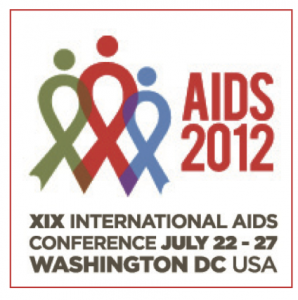Five-year results from raltegravir registrational studies
1 August 2012. Related: Conference reports, Antiretrovirals, World AIDS 19 Washington 2012.
 Simon Collins, HIV i-Base
Simon Collins, HIV i-Base
Two posters at IAS included five-year results from the phase 3 registrational studies of raltegravir.
A late breaker poster detailed the final five year results of the phase 3 placebo-controlled registrational study comparing raltegravir to efavirenz, that reported non-inferiority at primary and secondary endpoints of 48 and 96 weeks and superiority at week 192, largely driven by high side-effect related discontinuations in the efavirenz arm. [1]
The STARTMRK study randomised 566 treatment-naïve patients to either raltegravir to efavirenz, both plus tenofovir/FTC. Virological efficacy was measured as percentage of patients with viral load <50 copies/mL counting non-completers as failures. After initial non-inferiority, subsequent tests for superiority adjusted for previous analyses, although no formal hypotheses were formulated for week 240.
At five years, raltegravir continued to show superiority with 71% vs 61% suppressed to <50 copies/mL (difference +9.5; 95%CI +1.7 to +17.3), p<0.001). Numerically greater CD4 increases were also reported in the raltegravir arm: +374 vs +312 cells/mm3 (difference +62; 95%CI: 22, 192).
Discontinuations were reported in 25% of patients in the raltegravir (71/281) compared to 35% (98/282) in the efavirenz arm.
Virological failure occurred in 19.6% vs 20.9% of the raltegravir vs efavirenz arms, with non-response higher with efavirenz (3.6% vs 8.5%) but viral rebound higher with raltegravir (16.0% vs 12.4%).
Discontinuations due to clinical adverse events occurred in 5% (n=14) vs 9% (n=28), respectively. Drug-related side effects occurred less frequently with raltegravir: 52% (n=146) vs 80% (n=226), p< 0.001. Time to discontinuation was significantly earlier in the efavirenz group (observed = failure; log rank p-value = 0.023). However, fewer patients in the raltegravir group were using lipid-lowering drugs (9% vs 15%) and fewer patients initiated new lipid treatment (n=13 vs n =34).
Although the raltegravir arm reported significant benefits in fasting lipids (lower TC, LDL, non-LDL, all p<0.001 and TG, p=0.004) the higher increase in HDL with efavrienz meant that there was no significant difference in TC:HDL (-0.22 vs -0.08; difference -0.11; 95%CI -0.36 to +0.14, p=0.375).
Superiority with raltegravir is driven by fewer CNS side effects (dizziness/headache/drowsiness: 18% vs 50% and abnormal dreams/nightmare: 18% vs 31%) though discontinuations due to serious side effects (3.9% vs 3.5%) and numbers of deaths (1.8%, n=5 in each arm) were similar. Fatigue, GI-related side effects and rash also occurred more frequently with efavirenz.
A second poster presented five-year results from the BENCHMRK study that randomised 703 triple-class resistant, treatment experienced patients (2:1) to raltegravir or placebo, both with optimised background regimens. All patients had the option to switch to open-label raltegravir after three years. For the safety analyses different exposure rates were adjusted with results presented as event rates/100 patient years. Virological analyses at five years were also analysed based on responses at week 48. [2]
Patients randomised to raltegravir continued to have better virological response rates throughout five-years and this was not balanced by later access to raltegravir: 42% vs 16% for <50 copies/mL and 45% vs 17% using <400 copies/mL (non-completer=failure).
Exposure-adjusted rates of clinical adverse events were 20 vs 37 per 100 patient years of follow-up in the raltegravir vs placebo arm respectively.
comment
As a note to patient commitment, blinding was maintained for five years in STARTMRK and participants continued on a 6 pills a day, twice-daily combination, despite easier combinations if switched to open-label drugs. Tenofovir/FTC was taken in the morning with food, raltegravir (or matching placebo) was taken every 12 hours without regard to food, and efavirenz (or matching placebo) was taken at night without food.
Perhaps new drugs need longer or larger studies to be sufficiently powered to differentiate differences to similar comparitor arms, especially when a composite efficacy and tolerability endpoint is likely to show differences compared to efavirenz.
References:
- Rockstroh J et al. Long-term safety and efficacy of raltegravir (RAL)-based versus efavirenz (EFV)-based combination therapy in treatment-naïve HIV-1-infected patients: final 5-year double-blind results from STARTMRK. 19th International AIDS Conference. 22-27 July 2012, Washington. Poster abstract LBPE19.
http://pag.aids2012.org/abstracts.aspx?aid=21410 - Eron J et al. Final five-year results of the BENCHMRK studies: sustained antiretroviral effect of raltegravir and exploratory analysis of late outcomes based on early virologic response. 19th International AIDS Conference. 22-27 July 2012, Washington. Poster abstract TUPE025.
http://pag.aids2012.org/abstracts.aspx?aid=12576

